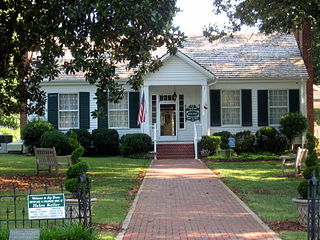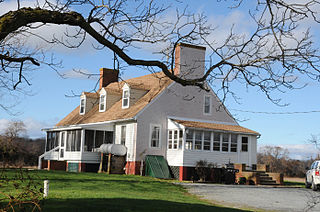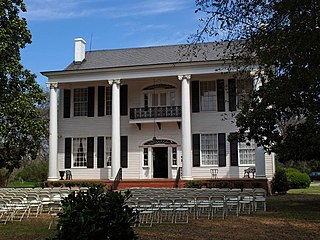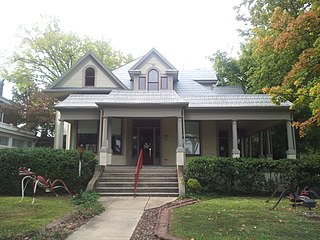
Ivy Green is a historic house museum at 300 West North Commons in Tuscumbia, Alabama, United States. Built in 1820, it was the birthplace and childhood home of Helen Keller (1880–1968), the famous deaf-blind author and speaker. A National Historic Landmark honoring Keller's life, it is now a museum open to the public.

Bachelor's Hope is a historic house in Centreville, Maryland. Built between 1798 and 1815, it was added to the National Register of Historic Places in 1984.

The Chase–Lloyd House is a historic house at 22 Maryland Avenue in Annapolis, Maryland. Built in 1769-1774, it is one of the first brick three-story Georgian mansions to be built in the Thirteen Colonies, and is one of the finest examples of the style. Its interiors were designed by William Buckland. Its construction was started for Samuel Chase, who would later be a signatory to the Declaration of Independence and Associate Justice of the Supreme Court, but Chase sold the building unfinished to Edward Lloyd IV in 1771. Lloyd completed the house in 1774 with assistance from Buckland and another architect, William Noke. The house remained in the Lloyd family until 1847, when it was sold to a relation of Chase. Hester Anne Chase was the daughter of Jeremiah Townley Chase who was Samuel Chase's cousin. When she died, she left the house to her 3 orphan nieces, Francis, Matilda, and Hester. In 1888 the house was bequeathed for use as a home for elderly women by the will of the last living niece, Hester. It continues in this use today. While the upper floors are off limits to visitors, the main floor and the extensive gardens are open to the public.

Magnolia Grove is a historic Greek Revival mansion in Greensboro, Alabama. The house was named for the 15-acre (6.1 ha) grove of Southern magnolias in which it stands. It was added to the National Register of Historic Places on April 11, 1973, due to its architectural and historical significance. It now serves as a historic house museum and is operated by the Alabama Historical Commission.

Sturdivant Hall, also known as the Watts-Parkman-Gillman Home, is a historic Greek Revival mansion and house museum in Selma, Alabama, United States. Completed in 1856, it was designed by Thomas Helm Lee for Colonel Edward T. Watts. It was added to the National Register of Historic Places on January 18, 1973, due to its architectural significance. Edward Vason Jones, known for his architectural work on the interiors at the White House during the 1960s and 70s, called it one of the finest Greek Revival antebellum mansions in the Southeast.

The Montgomery–Janes–Whittaker House, best known today as Buena Vista, is a historic Federal style plantation house in Autauga County, Alabama, south of Prattville. It was listed on the National Register of Historic Places on October 25, 1974. The house is currently owned by the Autauga County Heritage Association and operated as a historic house museum.

Belle Mina, known as Belmina during the 19th century, is a historic forced-labor farm and plantation house in Belle Mina, Alabama, United States. Completed in 1826, the Late Georgian-style house was built for Alabama's second governor, Thomas Bibb.

The Oates House is a historic home in Abbeville, Alabama. The house was originally built in 1900 by local farmer Ephraim Oates, cousin of Alabama Governor William C. Oates. In 1910, he greatly expanded the house, adding a second story and remodeling it in a Neoclassical style. The house was purchased in 1927 by the Shoemaker family, who added floor-to-ceiling casement windows to the front rooms.

The J. D. Holman House is a historic residence in Ozark, Alabama. One of the most elaborate Neoclassical homes in the Wiregrass Region, it was built in 1912–13 for Jesse DeCosta Holman, a prominent local merchant. The house was listed on the National Register of Historic Places in 1982.

The Phelps–Jones House is a historic residence in Huntsville, Alabama. One of the oldest buildings in Alabama, it was built in 1818, shortly after the initial federal land sale in Madison County in 1809. Despite having many owners, the original character of the house has remained. The two-story house is built of brick laid in Flemish bond, and has Federal and Georgian details. The original block has a bedroom and parlor separated by a central hall, with a dining room in an ell to the northeast. Staircases in the hall and dining room led to three bedrooms on the second floor. In 1956, a porch in the crook of the ell was enclosed, adding a bathroom and small bedroom. Another porch off the rear of the dining room was enclosed and converted into a kitchen. Interior woodwork, including six mantels, is in provincial Federal style. The façade is five bays wide, with twelve-over-twelve sash windows on the ground floor and twelve-over-eight on the second. A narrow hipped roof porch covers the double front door; originally a wider porch covered a single door flanked by narrow sidelights and topped with a transom. The house was listed on the Alabama Register of Landmarks and Heritage in 1979 and the National Register of Historic Places in 1982.

Greenlawn is a historic residence between Meridianville and Huntsville, Alabama. The house was built in 1849–50 by William Otey, replacing a log house built by his father in the early 1810s. Following William and his wife's deaths, the house was taken over by one of their granddaughters in 1907. Around 1925, the original Italianate portico was replaced with the current Greek Revival entrance, and a northern wing was added. The house fell vacant in 1963 and was later restored, now sitting at the entrance to a subdivision of the same name.

The William Koger House is a historic residence near Smithsonia, Alabama. The house was built around 1830 by William and Martha Koger, planters from Virginia. The Kogers brought their native architectural form, the Tidewater-type cottage, with them to North Alabama. The house was the center of a 630-acre (255-ha) plantation, which included an island in the Tennessee River. After William's death, Martha continued to manage the farm until her death in 1892.

The Wilson Park Houses are a group of three historic homes in Florence, Alabama. Built as upper-class residences between 1890 and 1918, the houses are adjacent to Wilson Park, laid out as a public space upon the city's founding and later renamed for President Woodrow Wilson. Two of the houses came to be owned by Hiram Kennedy Douglass, who upon his death in 1975 willed the houses to an organization willing to maintain them for the public. The houses are now owned by the city and contain the Kennedy-Douglass Center for the Arts. The houses were listed on the National Register of Historic Places in 1979.

The John and Archibald Christian House is a historic residence near Tuscumbia, Alabama. The house was built in the 1830s by brothers John and Archibald Christian, who were among a group of settlers from the Piedmont region of Virginia who came to Tuscumbia in the 1820s and 1830s. The family had left the house by the 1860s, and in the late 19th century, it was the home of Governor Robert B. Lindsay. In the 1900s, the house was the center of a dairy farm, before it and the surrounding 50 acres were acquired by the Tennessee Valley Country Club in 1923. The country club uses the house as a social meeting area and caretaker's quarters.

Johnson's Woods is a historic plantation house in Tuscumbia, Alabama. The house was built in 1837 on land purchased by George W. Carroll in 1828. A settler from Maryland, Carroll became the county's wealthiest planter by 1850. Between 1855 and 1860, he moved to Arkansas, selling his plantation to William Mhoon. Upon Mhoon's death in 1869, the plantation passed to William A. Johnson, a former Tennessee River steamboat operator and Confederate Army soldier. In addition to farming, Johnson also revived his steamboat business, traded cotton in Memphis, and opened a mercantile business in Tuscumbia. After his death in 1891 and his wife's in 1905, the land passed to his son, John W. Johnson.

The Felix Grundy Norman House is a historic residence in Tuscumbia, Alabama. The house was built in 1851 by Felix Grundy Norman, a lawyer who also served as mayor of Tuscumbia and in the Alabama Legislature from 1841–45 and 1847–48. Norman's father-in-law was the land agent for the sale of the Chickasaw lands, and his brother-in-law, Armistead Barton, built Barton Hall in nearby Cherokee, Alabama.

The Oaks is a historic residence near Tuscumbia in Colbert County, Alabama. Ricks came to North Alabama from Halifax, North Carolina in the early 1820s. He acquired a large plantation which he sold in 1826 and purchased nearby land. A log house had been built on the new property circa 1818, and Ricks built a new, larger house connected to it which was completed in 1832. The house remained in the family until 1966, and is still in use as a private residence.

The John Daniel Rather House is a historic residence in Tuscumbia, Alabama. The house was built in 1823 by William H. and Catherine Winter, who came to The Shoals from Prince William County, Virginia. It was taken over by the Union Army during the Civil War and used as the headquarters of General Florence M. Cornyn. After the war, the house was purchased by John Taylor Rather, an early North Alabama settler who was deputy sheriff of Madison County, and a longtime member of the Alabama House of Representatives and later the Alabama Senate. His son, John Daniel Rather, also served in both houses of the state legislature, and was President of the Memphis and Charleston Railroad.

The Ernest Edward Greene House is a historic residence in Cullman, Alabama. The house was built in 1913 by Ernest Edward Greene, the superintendent of Southern Cotton Oil Company. After Greene's death in 1922, the house was passed on to several more owners, including John George Luyben, Sr., who lived in the house for 34 years.

The Davis C. Cooper House is a historic house located at 301 Main Street in Oxford, Alabama.






















